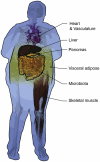Cellular senescence: Implications for metabolic disease
- PMID: 27591120
- PMCID: PMC5857952
- DOI: 10.1016/j.mce.2016.08.047
Cellular senescence: Implications for metabolic disease
Abstract
The growing burden of obesity- and aging-related diseases has hastened the search for governing biological processes. Cellular senescence is a stress-induced state of stable growth arrest strongly associated with aging that is aberrantly activated by obesity. The transition of a cell to a senescent state is demarcated by an array of phenotypic markers, and leveraging their context-dependent presentation is essential for determining the influence of senescent cells on tissue pathogenesis. Biomarkers of senescent cells have been identified in tissues that contribute to metabolic disease, including fat, liver, skeletal muscle, pancreata, and cardiovascular tissue, suggesting that pharmacological and behavioral interventions that alter their abundance and/or behavior may be a novel therapeutic strategy. However, contradictory findings with regard to a protective versus deleterious role of senescent cells in certain contexts emphasize the need for additional studies to uncover the complex interplay that defines multi-organ disease processes associated with obesity and aging.
Keywords: Aging; Diabetes; Exercise; Inflammation; Obesity; Senolytics.
Copyright © 2016 Elsevier Ireland Ltd. All rights reserved.
Figures



References
-
- Acosta JC, O'Loghlen A, Banito A, Guijarro MV, Augert A, Raguz S, Fumagalli M, Da Costa M, Brown C, Popov N, Takatsu Y, Melamed J, d'Adda di Fagagna F, Bernard D, Hernando E, Gil J. Chemokine signaling via the CXCR2 receptor reinforces senescence. Cell. 2008;133:1006–1018. - PubMed
-
- Acosta JC, Banito A, Wuestefeld T, Georgilis A, Janich P, Morton JP, Athineos D, Kang TW, Lasitschka F, Andrulis M, Pascual G, Morris KJ, Khan S, Jin H, Dharmalingam G, Snijders AP, Carroll T, Capper D, Pritchard C, Inman GJ, Longerich T, Sansom OJ, Benitah SA, Zender L, Gil J. A complex secretory program orchestrated by the inflammasome controls paracrine senescence. Nat. cell Biol. 2013;15:978–990. - PMC - PubMed
-
- Al-Aubaidy HA, Jelinek HF. Oxidative DNA damage and obesity in type 2 diabetes mellitus. Eur. J. Endocrinol./Eur. Fed. Endocr. Soc. 2011;164:899–904. - PubMed
Publication types
MeSH terms
Substances
Grants and funding
LinkOut - more resources
Full Text Sources
Other Literature Sources
Medical

